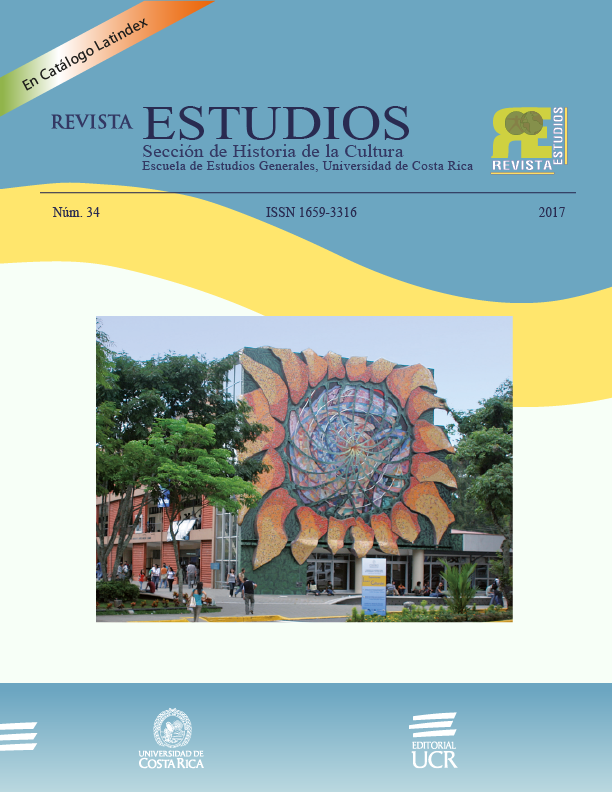Abstract
This investigation is about the cultural identity in the Guanacastecan traditional dance as structural process performed by children and youngsters who are part of the Taller de Danza Folclórica Nahualt. This study is done taken into account the structural features proposed by John B. Thompson in his theory about the symbolic forms and the historical and contextual structured processes these symbols belong to. The symbolic forms are identified in two different shows and the pertinent analysis is done. This study shows that the theory is applicable to the dance itself and it is proved that, through the symbolic and contextual analysis, the fusion of symbols with the historical and anthropological contexts is appropriate, but it is not a source of meaningful cultural identity. With this research, the Essencialism in the Guanacastecan traditional dance is deprived from its main arguments, because the analysis of this cultural practice disputes about the true essence of the Guanacastecan traditional dance, which makes it an interesting object of study.
References
Alfaro, J. (1981). El vocabulario del trapiche costarricense. Letras, 1(8), 217–257.
Anderson, B. (1983). Imagined Communities. Londres: Verso.
Augé, M. (1995). Hacia una antropología de los mundos contemporáneos.
Barcelona: Gedisa.
Bourdieu, P. (1988). Cosas dichas. México: Gedisa.
Cabrera, R. (2007). Tierra y ganadería en Guanacaste. Cartago: Editorial
Tecnológica de Costa Rica.
Cohen, A. (1982) Belonging, identity and social organization in British rural cultures. England: Manchester University Press.
Convención para la Salvaguardia del Patrimonio Cultural Inmaterial de la
UNESCO. (2003).
Barreiro, D. (2013). El patrimonio era otra cosa. Instituto de investigaciones arqueológicas y museo, 45, 6.
Derechos Culturales. Declaración de Friburgo. (2007). Cultura y desarrollo.
Descartes, R. (1646, 1649): “René Descartes: From the Letters of 1646 and 1649”, en Linda Kalof y Amy Fitzgerald (2007): The Animals Reader. The Essential Classic and Contemporary Writings. Oxford: Berg Publishers, pp. 59-62.
Geetz, C. (1973). La interpretación de las culturas. Barcelona: Gedisa.
Grupo de Friburgo. 1996. «Project conceming a declaration of cultural rights». París, UNESCO, 4 de septiembre. Recuperado de
http://www.unifr.chliiedh/langues/english/DC/decLdc.html
Hall, E. (1981). Beyond culture. New York: Anchor Books (Random House Inc.).
Heidegger, M. (s. f.). El principio de identidad. Recuperado de
http://www.udec.cl/~alejanro/pepe/hei4.pdf
Marchena, J. El nacimiento de las corporaciones azucareras en Guanacaste 1890-1970. Diálogos [en línea]. 17 de abril de 2015, núm. 2. [fecha de consulta: 27 junio 2016]. Recuperado de
http://revistas.ucr.ac.cr/index.php/dialogos/article/view/18106/19930.
Oficina Regional de Educación para América Latina y el Caribe. (2008).
Declaración Universal de los Derechos Humanos. Santiago, Chile.
Paasi, A. (2003). Region and Place: region identity in question. Progress in human geography 27. (4), 475-485.
Pintos, Mª Luz (2002): “Cuerpo de mujer y violencia simbólica: una realidad universal”, en Jacinto Rivera de Rosales y Mª del Carmen López Sáenz (coord.): El cuerpo. Perspectivas filosóficas. Madrid, UNED, pp. 291-316.
Quijano, A. (1999). Colonialidad del poder, cultura y conocimiento en América Latina. Textos básicos. México, DF Fondo de Cultura Económica.
________, A. (1992). Colonialidad, modernidad/ racionalidad. Perú Indígena, 13(29), 13.
Rulicki, S., y Cherny, M. (2007). CNV comunicación no-verbal: cómo la inteligencia emocional se expresa a tráves de los gestos. Buenos Aires: Granica.
Schütz, A. (1993). La construcción significativa del mundo social, España: Paidós.
Sequeira, W (1985). La hacienda ganadera en Guanacaste: Aspectos económicos y sociales, 1850-1900. San José: Editorial de la Universidad Estatal a Distancia. p 59.
Thompson, J. (1998). Ideología y cultura moderna. México: Universidad Autónoma Metropolitana.
UNICEF. (1990). Convención sobre los derechos del niño. España: UNICEF.
Yúdice, G., y Ventureira, G. (2002). El recurso de la cultura: usos de la cultura en la era global (1.ed). Barcelona: Gedisa.

